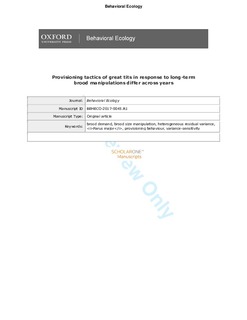Provisioning tactics of great tits (Parus major) in response to long-term brood size manipulations differ across years
Mathot, Kimberley J; Olsen, Anne-Lise; Mutzel, Ariane; Araya-Ajoy, Yimen; Nicolaus, Marion; Westneat, David F.; Wright, Jonathan; Kempenaers, Bart; Dingemanse, Niels J.
Journal article, Peer reviewed
Accepted version
Permanent lenke
http://hdl.handle.net/11250/2468716Utgivelsesdato
2017Metadata
Vis full innførselSamlinger
- Institutt for biologi [2579]
- Publikasjoner fra CRIStin - NTNU [38228]
Sammendrag
Parents provisioning their offspring can adopt different tactics to meet increases in offspring demand. In this study, we experimentally manipulated brood demand in free living great tits (Parus major) via brood size manipulations and compared the tactics adopted by parents in 2 successive years (2010 and 2011) with very different ecological conditions. In 2011, temperatures were warmer, there were fewer days with precipitation, and caterpillars (the preferred prey of great tits) made up a significantly larger proportion of the diet. In this “good” year, parents responded to experimental increases in brood demand by decreasing mean inter-visit intervals (IVIs) and reducing prey selectivity, which produced equal average long-term delivery of food to nestlings across the brood size treatments. In 2010, there was no evidence for effects of brood size manipulations on mean IVIs or prey selectivity. Consequently, nestlings from enlarged broods experienced significantly lower long-term average delivery rates compared with nestlings from reduced broods. In this “bad” year, parents also exhibited changes in the variance in inter-visit intervals (IVIs) as a function of treatment that were consistent with variance-sensitive foraging theory: variance in IVIs tended to be lowest for reduced broods and highest for enlarged broods. Importantly, this pattern differed significantly from that observed in the “good” year. We therefore found some support for variance-sensitive provisioning in the year with more challenging ecological conditions. Taken together, our results show that variation in brood demand can result in markedly different parental foraging tactics depending on ecological conditions.
